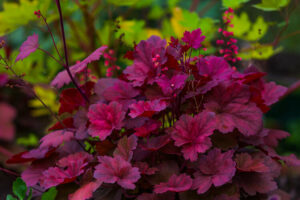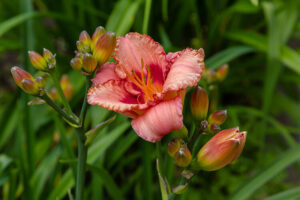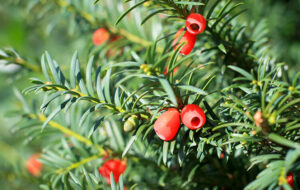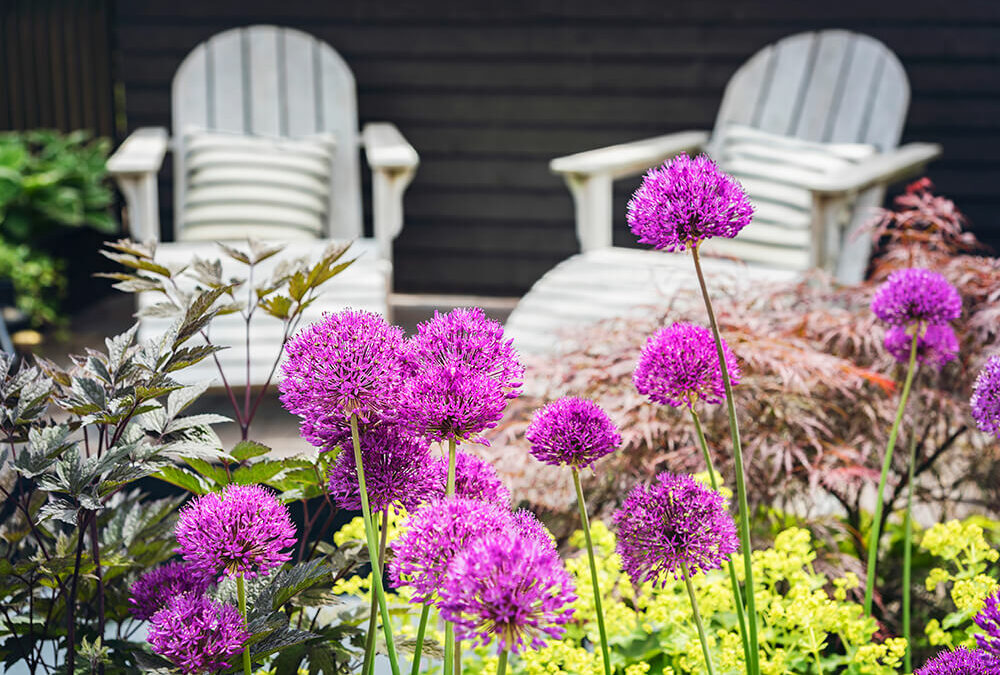With the dog days of summer mere weeks away, homeowners want to spend more time outside, but not necessarily more time working in their gardens.
One of the most common requests we receive when working with new landscaping clients is for a low-maintenance design. This usually means, very little work in terms of watering, weeding, dead-heading, and pruning.
While no garden or flowerbed, is maintenance-free, we’ve put together some tips below to help you minimize your gardening workload, so you can maximize relaxation this summer.

Honeysuckle (Lonicera)
Stave off drought with these tips
Before we look at plants that tolerate hot, dry conditions well, let’s talk about your soil. Generally, plants enjoy soil that drains well. Soil that doesn’t (typically clay-based soil) can contribute to root rot and may claim otherwise healthy plants. However, soil that drains well can quickly become too dry in hot, windy, and/or dry weather.
The key to maintaining soil moisture is mulch. We recommend a thick layer (three to four inches) of mulch on flowerbeds and around trees. Mulch comes in a variety of types and colours and not only helps soil maintain moisture, but also helps keep weeds to a minimum, and gradually breaks down to help nourish the soil.
Another tip for maintaining a drought-tolerant and sustainable landscape is to collect run-off rainwater in a rain barrel. Strategically placed under a downspout close to your gardens, harvested rainwater can get your plants, shrubs, and trees through the drier spells of summer.

Coral Bells (Heuchera mirachantha)
Drought-tolerant plants for Southwestern Ontario summers
Generally speaking, the more established a plant or tree is, and the deeper the root system, the better it will tolerate drought. That generally takes care of trees and evergreen shrubs, but you’ll still need to tend to well-established deciduous shrubs and perennials during spells of extreme dryness.
The following are a small sampling of drought-tolerant species.
Perennials
Honeysuckle Vine (Lonicera)
Fragrant and colourful, the honeysuckle can be trained on a trellis or arbour and is a favourite of pollinators and hummingbirds.

Daylily (Hemerrocalis)
Coral Bells (Heuchera mirachantha)
Foliage ranges from purple and red to bright green and plant produces tiny, bell-like flowers. Mounding and provides excellent ground cover in shade gardens.
Daylily (Hemerrocalis)
Available in an extremely wide range of colours with both solid and variegated foliage, the exotic-looking flowers of these super-hardy perennials also attract pollinators.
Switch Grass (Panicum virgatum)
This sturdy grass provides dense mounds of colour (depending on the variety) including yellow, green, red, and purple. Flowers stretch on thin stalks above foliage.

Lenten Rose (Helleborus occidentalis)
Lenten Rose (Helleborus occidentalis)
Has sturdy foliage and blooms in early spring, bringing shades of pink, purple, blue, green, and yellow to your garden. Prefers shade or dappled sunlight.
Shrubs
False Cypress (Chamaecyperas psifera)
This evergreen species lends dense structure to gardens. With foliage in a range of colours from gold to emerald green and blue, it’s great for adding both privacy and visual interest.

Yew (Taxus)
Yew (Taxus)
This dense shrub can be planted on its own, but is commonly planted in a row to create a hedge or natural privacy screen. Female specimens develop showy, red berries.
Panicle Hydrangea (Hydrangea paniculata)
Beautiful clustered blooms in pale green and white to pale and vibrant pink. Browning flowers/seedheads remain on shrubs well into winter, providing visual interest and (when planted near a food source) a place for winter birds to perch.
Butterfly Bush (Buddleia)
Blooming in mid-summer, the long clusters of flowers in bold hues attract butterflies and last until first frost, providing colour when most other flowers’ blooming periods have ended.

Butterfly Bush (Buddleia)
Sumac (Rhus typhina)
Ranging in size from compact to large, this shrub’s feathery foliage is bright green during the warmer months, but is better known for its eye-catching fall colours including bright yellow, orange, and red.
Succulents
While not native to our region, succulents are the camels of the plant world, maintaining an internal water supply that sees them through long periods of drought. However, not all succulents can survive Ontario winters, so we do need to be somewhat selective unless we transplant to pots to bring indoors for the winter months.

Sedum Autumn Joy (Herbstfreude)
There are a couple winter-hardy selections that add visual interest and are incredibly low-maintenance. The Autumn Sedum, which is a lower growing perennial, blooms in the fall, providing dashes of colour when many other flowering plants are already spent. And Sempervivum (commonly known as “Hens & Chicks”) is hardy in flowerbeds and rocks gardens, but also works well in containers, both outdoors and indoors.
While these tips may provide you with information that helps you determine a general direction in which you’d like to take your landscaping, you might not have the tools, equipment, or time to create the beautiful, low-maintenance outdoor experience you’re hoping for. We invite you to contact us any time for assistance with landscaping design and installation.

